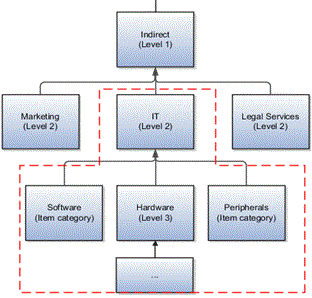Organisations
that are reactive in their purchasing activities and have no clear procurement
goals are now realising that they are not getting the best value out of their
third party controllable spend. By processing day-to-day transactions without a
plan, they could be paying too much for their goods and services.
Using a structured approach to high-value purchasing activities, by
categorising historical spend, creates opportunities for savings and extracting
more value from suppliers. According to the Chartered Institute of Procurement
and Supply (CIPS): “Category management is a strategic activity which organises
procurement resources to focus on specific areas of spends”.
An example of a category would be information technology (IT). It may have many
sub-categories (commodities) such as software, hardware and peripherals.
Further sub-categories can be added to provide a further level of detail (see
graph below).

5 steps to managing a category:
1. Define the category and sub-categories (commodities).
2. Perform a detailed spend analysis of the category based on the analysis of
the commodities within it.
3. Do a supply market analysis per commodity and continuously monitor it.
4. Apply this market intelligence to make improvements to specifications, find
new suppliers or change the scope of work.
5. Use this knowledge to actively manage strategic purchases and transactional
purchasing.
The benefits of category management
The main objective is to manage each category and sub-category of spend holistically,
through the entire procurement lifecycle. By implementing category management
procurement staff can focus their time wisely and not waste resources on
repetitive transactional buying. Spend on a commodity or a service can be
leveraged to offer larger volumes or scope to suppliers. It also highlights
cost avoidance opportunities and potential quick wins.
In more advanced procurement teams, category management extends to setting up
category boards that are responsible for the company strategy relating to that
category. This is used extensively for high-value categories such as raw
materials, energy, information technology, facilities and professional
services.
6 pre-requisites for successful category
management
1. An in-depth understanding of the organisation’s future plans and business
strategy so that the categories are aligned to goals.
2. Continuous analysis of spend, market data, and benchmarks to identify additional improvement opportunities.
3. Continuous price analysis on local and international markets and monitoring of trends in the category.
4. Capturing of supplier performance data to drive quality and service improvements.
5. Tracking of additional savings actually achieved through substitutions, better compliance, negotiations.
6. Ongoing stakeholder discussions and reviews to ensure that all affected
parties and users are involved in decisions on the category.
Category management is the best-practice method used in professional
procurement organisations to manage purchasing of high-value goods and
services. However, it is a continuous process, and it forms the basis for
successful strategic sourcing initiatives – but only provided it is both well
managed and given the right level of attention.
Contributed
by: Elaine Porteous, a Senior Assocaite at Bespoke and a regular contributor to
Bespoke Procurement Bulletin and a
freelance business writer and commentator on supply chain and talent management
- www.elaineporteous.com
Article first appeared in Bespoke
Procurement Bulletin: 